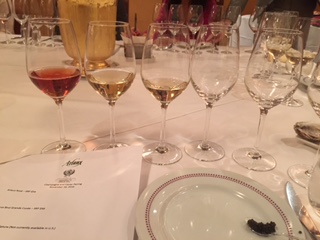What a wonderful visit to Domaine Ferrer Ribiere in Terrats. This is a small winery in the foothills of the Canigou, just 15 km South-West of Perpignan, near Spain. The Domaine consists of 29 hectares of vineyards located on a variety of soil types. The plots are small and the altitude is high, allowing for very fresh wines with excellent expression of terroir.
The domaine is owned by two partners, Denis Ferrer who takes care of the vines, and Bruno Ribiere, who makes the wines and in doing so, endeavors to express the soils and vines his partner has tended. The men try to work in an organic and biodynamic way.
Our guide on this day is Bruno Ribiere, a gentleman who loves experiments and often talks about philosophy as he does wine, giving visitors the impression that they are one in the same thing. He is also something of a “mad scientist” in the best sense of the word, as he loves to experiment.
As we are shown around the winery we see odd yet intriguing equipment, such a giant egg that is made out of a lighter weight synthetic material, not the typical (and expensive) concrete. It is less expensive than the concrete egg, yet accomplishes the same function.
When it comes time to taste the wines, we sit down and begin with the 2016 Grenache Blanc Cotes Catalanes. It is a delicious wine with 14% abv and a deliberate oxidative quality that makes it excellent for pairing with fine cuisine.
The next wine is the Grenache Gris 2015, with 14.5 % abv and again a saline minerality, with some positive flavors of green olives.
The Cuvee F 2015 is made of Carignan and Grenache, and it is a very rich complex wine. It is made in a traditional way for the region, with the Carignan vinified separately in a carbonic way (the grapes undergo intracellular fermentation) which is said to soften their tannins. The Grenache is vinified as usual and they are blended.
![Ferrer Ribiere]()
Ferrer Ribiere
The Cuvee 1887 is made from Carignan and is absolutely delicious, a very dark purple black color and aromas of wild violet. The silky tannin is a result of being aged in the egg shaped maturation vessel we saw in the winery. The fabulous flavors here are that of wild herbs, garrigue, and earth.
Syrah Nos Saurus Rex is an inky black color, aged in Demi-muid and again offers bold, magnificent bold red/black fruit. This is followed by the 2015 Mourvedre, a rich fuller bodied wine clocking in at 15.5% abv with ripe, structured tannins.
The 2001 blend of Grenache, Syrah, and Carignan has 17% abv, but you do not feel its warmth because of the rich texture and elegant expression, along with the lively acidity. The fermentation for this wine lasted a month, and the texture was like jam. Afterwards, the wine was put into barrel and aged under close observation.
We try the Vin Doux Naturel, which has zesty acidity and stony minerality. The grapes are picked when exactly ripe, not over-ripe.
But how do they know when to pick? “When the wild boars come out,” says Bruno, in all seriousness. For centuries, it seems, the wild boars know the exact moment the grapes are ripe.
We try some other delicious sweet wines, such as the 2015 Matero cuvee with succulent flavors of blackcurrant and blueberry, and the Rancio 2003, a delicious wine made in a deliberately oxidative style that I find delicious. It is made from a blend of Macabeo, Grenache Gris, Grenache Blanc, Malvasia, Muscat (both of Alexandria and Petits Grains) that would be delicious with cheese.
The last wine is the No Restriction 2016, a sweet wine with a tawny color and aromas of nuts and heavy white flowers.
What a lovely visit to the winery of two passionate gentlemen who love producing delicious wines.
The post Visit to Domaine Ferrer Ribiere appeared first on Wine Reviews: A Wine Story.
 Warm and gregarious, M. Cuvelier greeted us and showed us around the property, just a two minute walk from the center of St Emilion.
Warm and gregarious, M. Cuvelier greeted us and showed us around the property, just a two minute walk from the center of St Emilion.




























